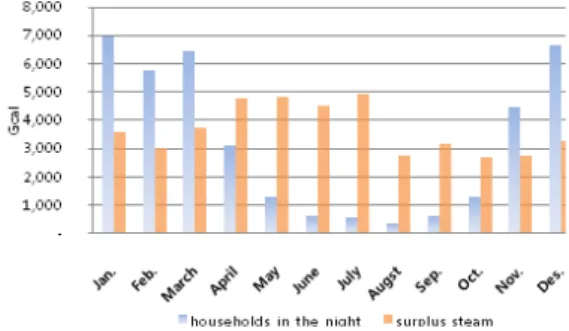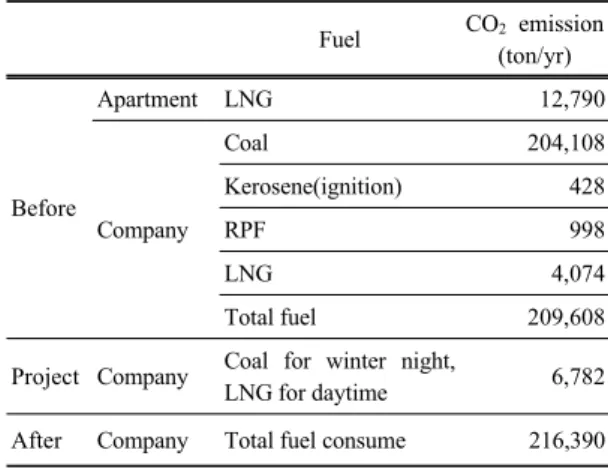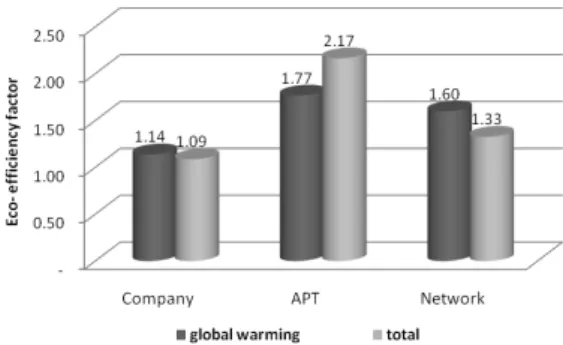Eco-efficiency of Energy Symbiosis for the Energy Network of Surplus Heat
Choon-Hwan Shin, Ji-Won Kim
1)*
Department of Energy & Environment, Dongseo University, Busan 607-716, Korea
1)
Institute for Environmental Technology and Industry, Pusan National University, Busan 609-735, Korea (Manuscript received 21 December, 2011; revised 2 February, 2012; accepted 22 March, 2012)
Abstract
Eco-efficiency considers both environmental impacts and economic values. It is a useful tool for communicating with
stakeholders for business decision making. This study evaluated the eco-efficiency factor (EEF) for the energy network of
a dyeing company that supplies surplus heat to a neighboring apartment during the night. This symbiosis network is one of
the eco-industrial park (EIP) projects in Korea and aims to benefit local residents and the industrial complex by utilizing
surplus heat. In this study, two categories were annualized. The first quantified environmental burden based on CO2
emissions and quantified product value in terms of steam sales. The second used a variety of environmental factors, such
as fossil fuel, water and waste, to quantify environmental burden and used steam sales to quantify value. The EEF of the
symbiosis network was 1.6, using the global warming impact, and determined using the multiple variable, was 1.33. This
study shows that the EEF depends on variable details of environmental burden but the values of this project were very high
contrast to other business or EIP project.
Key Words : Eco-efficiency, Industrial symbiosis, Eco-industrial park, District heating, Multiple variables
1)
1. Introduction
The lifestyle we enjoy in the twentieth century, thanks to mass production, mass consumption and mass disposal, has placed a heavy impact on the environment, which has resulted in a variety of critically dangerous circumstances, such as global warming, waste problems, water quality deterioration and the presence of harmful chemical substances. We should be considerate of not only economic benefits but also of environmental impacts of sustainable development. To evaluate the effect of production and environmental burden, the term eco-efficiency, the synthetic word of eco (ecology and economy) and
*Corresponding author : Ji-Won Kim, Institute for Environ-
mental Technology and Industry, Busan 609-735, Korea
Phone: +82-51-510-2496
E- mail: envjjang@nate.com
efficiency, was officially adopted at the earth summit in Rio de Janeiro, Brazil in 1992. Most commonly, eco-efficiency is defined as the ratio between the value added by and the environmental impact of a company’s operational processes (Schaltegger and Sturm, 1992; Helminen, 2000). It is defined as a combination of economic and environmental (ecological) efficiencies expressed by the ratio:
(1)
The eco-efficiency indicator is used by companies as a decision tool to measure the increasing performance of a product and the decreasing environmental impact.
It is a useful tool for monitoring sustainable
development; for example, if the environmental
surplus steam is not transferred to the apartment during the day (Fig.3). Therefore, carbon dioxide emissions are increased with these fossil fuels for in the district heating configuration, even if it is lower than before this EIP project began (Fig.4).
Fig. 3. The additive use of the fossil fuel.
Fig. 4. The comparison of CO
2
emission.
3. Results and Discussion
3.1. The global warming eco-efficiency factor This EIP network promotes additional steam sales (to the apartment building as well as to the dyeing companies), which has an economic benefit for the company. However, the EIP also creates an additional environmental burden in terms of CO
2
(Tables 1-2).
The efficiency considerations play an important role in evaluating corporate carbon performance (Hoffmann and Busch, 2008). To calculate CO
2
emissions, various fossil fuels that are used in the CHP plant, such as coal, kerosene, RPF and LNG, were considered as input variables before the project. Coal for the winter nights and LNG for year round daytime
use were considered as input variables after the project. To obtain the EE of the CHP plant, the economic benefit (based on calories) was as selected steam sales, and CO
2
was used to assess the environmental burden.
Table 1. Steam sales from the CHP plant before and after
the EIP project
Items Steam sales
(Gcal/yr) Before Sales for dyeing company 271,587
Project
Surplus steam in the night 24,226 Additive supply in the night (winter) 13,939
Additive supply in the daytime
(all year) 9,541
Total sales for apartment 47,706
After Total steam sales 319,293
Table 2. CO
2 from various fossil fuels before and after the
EIP project
Fuel CO
2
emission (ton/yr)
Before
Apartment LNG 12,790
Company
Coal 204,108
Kerosene(ignition) 428
RPF 998
LNG 4,074
Total fuel 209,608
Project Company Coal for winter night,
LNG for daytime 6,782
After Company Total fuel consume 216,390
The eco-efficiency factors of the company and the apartment building were 1.14 and 1.77, respectively, as shown in Table 3. These values are very high;
therefore, this project can be considered to be
sustainable development. In the case of the




